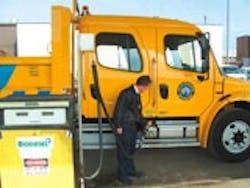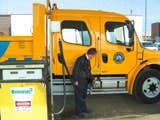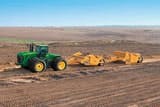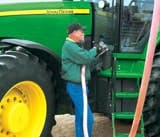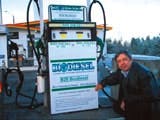Biodiesel Strategies
Not all fleet managers believe that biodiesel is ready for prime time. One of them is Robert Andrade, CEM, vice president, asset management for Parsons.
“There are so many requirements that it’s more of a problem than a benefit for us,” he says. “Even climate considerations are involved.”
In addition to temperature, he cites labor expenses, fuel storage that requires close monitoring, and warranty questions.
Biodiesel is readily available for Parsons’ operations in Sumner, Washington, but “big emblems” are posted on pumps that caution buyers that they might not want to use the fuel if the temperatures is below 45 F.
“That’s because the fuel supplier doesn’t want to get pinged for leaking gaskets, gelling and fuel filter clogging,” Andrade says. “In the Pacific Northwest, the temperature is always bouncing between 30 degrees at night and maybe 50 degrees during the day. Those types of temperature ranges eliminate about four months of the year.”
Andrade says cost is a concern, especially in a union area, for the extra labor associated with testing, keeping stock segregated, and monitoring the fuel for microscopic growth.
Moisture contamination is a problem. “You have to minimize the moisture condensation to keep it stored,” Andrade says. “That means vehicle tanks have to be as full as possible at all times. You have to keep testing the fuel, but how often depends on the grade of the biodiesel: B15, B20, B100. Each blend requires different test periods. The more biodiesel you have, the more you have to test it, the more you have to monitor it.”
If a machine goes down, fuel will sit in the tank. “With some crane parts, you can wait for six months,” Andrade says. He says the limited use of biodiesel among fleets “is simply because our industry is not very good at fuel management to start with.
“With biodiesel, you have to take fuel management to the next level,” he says. “That might work in a high-production environment, but construction is not high-production. Many fleets don’t have the resources to take care of the costs associated with monitoring, testing and storing the fuel.”
Finally, Andrade says he’s concerned about the risk exposure surrounding engine warranties. He says fleet managers need to be aware that if biodiesel causes a problem, the engine may not be covered by the warranty.
Although biodiesel has been around since farmers discovered that crop remains, such as soybeans and corn, could be burned as fuel for tractors, it didn’t leave the farm for the big city until a few years ago.
Biodiesel and other alternative fuels were shoved to center stage by the ratcheting up of government demands for a cleaner environment and the disturbing realization—pounded home by spiraling fuel prices—that the United States had become just as dependent on oil-rich nations as a smoker is to cigarettes.
One of the first steps toward addressing both problems of a cleaner environment and petroleum diesel withdrawal were efforts to find alternative fuels. Ramped-up demands from federal and state agencies such as the Environmental Protection Agency (EPA) and the California Air Resources Board (CARB), linked with political pressure, lit a fire under the search for alternative fuels.
Today many fleets, particularly municipal, are successfully using biodiesel. Proponents say it is a renewable, oxygenated fuel made from agricultural resources; is biodegradable; and is free of sulfur. But before fleet managers jump in and introduce biodiesel into their fleets, certain factors must be considered.
Biodiesel is created by combining lesser amounts of petroleum diesel with processed vegetable oil, animal fats, corn, soy, or recycled oil products. It has become one of the leaders in first-generation alternative fuels. Blends are identified by the letter “B” and a number, which represents the percentage of bio-products in the blend. For example, B20 has 20 percent bio and the rest is petroleum diesel.
These blends can be used in compression ignition engines with little or no modifications, according to the Navistar Engine Group. Generally speaking, OEMs have been slow to approve biodiesel, primarily because no standards existed that would ensure the quality of the fuel when it was refined. In the past, OEMs warned fleet managers that biodiesel use could void the engine warranty.
Although OEMs were in the forefront in researching alternative fuels (John Deere was the first off-highway engine manufacturer to recommend biodiesel and factory-fill it in North America), some had concerns about the availability and consistency of suppliers; increased NOx emissions from biodiesel; compatibility of seals, gaskets and other material; cold-weather performance; stability and storage; thermal degradation at elevated temperatures; and lower energy content.
Today, however, the OEM comfort zone has greatly improved, thanks to two industry standards. One is BQ 9000 from the National Biodiesel Board, a national biodiesel accreditation commission. The second is ASTM D6751. Both address how biodiesel is processed and handled.
Joe Mastanduno, product marketing manager for engines and drivelines at John Deere Forestry and Construction, says the standards have enabled the fuel to become a mainstream product.
“These standards were developed over the last few years to make sure the fuel is produced and handled correctly,” he says. “That was one of the problems biodiesel had in the past. Everybody produced it and handled it differently, so when it got to the user it did not have the desired affects sometimes. Today biodiesel is a real product.”
Volvo Construction Equipment also waited for biodiesel standards, according to John Bartz, emissions solutions manager.
“There was really nothing out there to measure biodiesel against,” he says. “Now that we have a yardstick to hold biodiesel up to, I think many OEMs feel more comfortable about it. Although standards don’t guarantee quality, this goes a long way toward a more stable supply base.”
During the past two or three years, many engine manufacturers have approved B20 and other blends for their engines, according to Mastanduno, but he cautions fleet managers to confirm that with individual engine OEMs. Fuel systems need to be approved, too.
At Volvo, Bartz says biodiesel can be used across the company’s entire product line. “There is a different percentage for smaller engines versus larger engines, but all are approved for at least B5,” he says.
Navistar has approved biodiesel in blends up to B20 for all International engines. Although engine modifications might be required for some engines, those manufactured in 2007 and beyond need none to accommodate the use of B20. Some states now mandate B20, so Navistar’s MaxxForce engines can safely burn that blend. Navistar also approves blends of biodiesel up to B5 in all MaxxForce engines prior to 2007, provided the fuel meets ASTM D6751 and D975 standards, according to a company information sheet.
Caterpillar allows B30 to be used on most engines under the condition that the biodiesel and the final blend meet the appropriate specifications.
“There are numerous items to consider beyond this,” says Jared Parsons, a fuel/coolant engineer with Caterpillar. “They are laid out for end-user consideration in our company documents, such as Caterpillar Machine Fluids Recommendations.”
Even so, biodiesel raises questions as to what types of fuel-related failures individual manufacturers may exclude from warranty coverage.
Jeffrey Tews, fleet operations manager for the City of Milwaukee (Wis.), has no qualms about using biodiesel. He has 493 pieces of construction equipment, 260 dump trucks, 200 refuse trucks, and 150 other miscellaneous vehicles running on the fuel. And he has a mixed fleet that includes engines manufactured by Caterpillar, Cummins, John Deere and others.
Tews gradually introduced biodiesel into his fleet. He started with B2 in the latter part of 2006. In 2007 he “ramped up” to B5 and later in the year to B10. “For a good portion of 2008, we burned B20,” he says.
Tews said the end result has been pretty much what he expected, thanks to extensive research he did before trying biodiesel. He discovered, for example, that biodiesel was a detergent and so expected an increase in filter changes.
“We knew we would be changing fuel filters at an accelerated rate,” he says. “The first full year of use we saw almost a two-fold increase in the amount of fuel filters we replaced. Anything that is in the tank is basically being cleaned up and is caught in the filters.” The high rate of filter changes lasted for about a year, then it started to taper off as the system became cleaner.
The fuel changeover did not require any changes in storage, Tews says. “We just started pouring B2 into our storage tanks. We didn’t have to change any infrastructure, we didn’t have any O-ring problems, and we didn’t have to do any costly modifications.”
Maria Redmond, biofuel sector specialist for the Wisconsin Office for Energy Independence in Madison, suggested cleaning tanks before converting.
“The conversion is minimal,” she says. “You clean the tank out so there is no diesel residue in it, depending on how old the tank is. The tank should be evaluated to see if it has the proper valves. If not, the Department of Commerce, which does the inspection, recommends investing in a new tank.”
Biodiesel should not be stored any longer than six months, either, as it is susceptible to algae and water, OEMs warn.
Tews also found that biodiesel does not have the same amount of BTUs per gallon as petroleum diesel, so he did not expect any increase in fuel economy.
“However, we definitely have cleaner emissions as a result of biodiesel,” he says. “For example, when you burn B20 you are decreasing your hydrocarbons by about 20 percent and decreasing your carbon monoxide and particulate emissions by about 12 percent each.”
Running biodiesel does cost a little more, but Tews called that expense marginal. “We found it worked out to about one penny per percentage point. That’s about two cents more per gallon than the cost of just petroleum-based diesel.”
By coincidence, when he started burning biodiesel in August 2006, it was right before the big change-over to ultra low sulfur fuel, which weakens lubricity. “What we lost in lubricity with the new fuel we made up for with the 2 percent biodiesel,” he says. “The timing couldn’t have been better.”
Last year, Tews’ municipal fleet burned 175,000 gallons of biodiesel. He generally burns about 1 million gallons of regular diesel per year, and he’s looking to increase biodiesel use this year.
The Wisconsin Office for Energy Independence will help to connect fleets with a qualified biodiesel supplier, Redmond says. Her office routinely bids out for fuel every two years, but biodiesel has not been included due to a lack of demand. All that changed recently.
“Currently [fleets] can go to any supplier they choose to purchase the fuel,” Redmond says. “The next time we go out to bid we will include biodiesel.”
Redmond illustrates the state-wide trend toward biodiesel with these statistics: The consumption of B20 in 2006, when biodiesel was first used, totaled 6,404 gallons. In 2007, consumption went up to 60,331 gallons. When statistics are finalized for 2008, she says, biodiesel consumption should be only slightly more than was used in 2007.
“That’s because the biodiesel industry itself has slowed down,” she says. “There hasn’t been that much consumption in Wisconsin recently. Production issues and quality concerns accounted for the slowdown in the state.”
Wisconsin is working toward a 10-percent reduction in petroleum-based diesel by 2010. One of the biggest challenges her agency faces, Redmond says, is price.
“It’s hard for us to push biodiesel when fleets in each of our agencies have tight budgets due to the economy,” she says. “Biodiesel is more expensive. By the formula we use, B2 is about two cents higher than regular diesel; B5 is five cents higher; B10, 10 cents higher; and so forth. There are tons of benefits, but price and cold flow are issues.”
Other concerns identified with biodiesel include moisture absorption, incompatibility with some filters in the field, increased servicing of engine components, possible oxidation at elevated temperatures, possible formation of sludge and sediments, and possible damage to paint exposed to biodiesel.
Many of these issues will be resolved as biodiesel is improved, Redmond says.
“Biodiesel and the other present-day alternative fuels have provided a good base for future development,” she says. “We are very aware of carbon footprint. We don’t want to create a bigger problem than we solve.”
